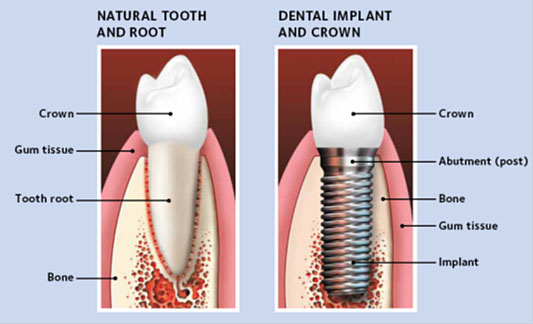Dental Implants
Nothing can take the place of a healthy set of natural teeth. But when disease or an accident ends in tooth loss, it's good to know that there are options for restoring your smile. You may want to choose dental implants if you:
- are self-conscious because you have missing teeth
- wear dentures that are uncomfortable for you
- are unsatisfied with your removable partial dentures
- do not want to have intact tooth structure removed to have a fixed bridge placed
Many patients choose implants to replace a single tooth, several teeth, or to support a full set of dentures. Implants are posts that are surgically placed in the upper or lower jaw, where they function as a sturdy anchor for replacement teeth. They are made of titanium (a strong, lightweight metal) and other materials that are accepted by the human body.
Implants are a popular and effective way to replace missing teeth. The development and use of implants has been one of the biggest advances in dentistry in the past 40 years. U.S. dentists place more than 5.5 million implants annually.
The Benefits of Implants
Implants fuse with the jawbone, offering firm support to man-made teeth. Dentures, bridges or single teeth mounted to the implants won’t slip or shift in your mouth—a very important benefit when eating and speaking. This secure fit also helps man-made teeth feel more natural than typical bridges or dentures. And dental implants help to preserve the bone after teeth are lost or extracted. Implants are a good value, because they can last a lifetime with good care.
Single Tooth Implants

The single tooth implant replaces the missing tooth's roots. A single tooth implant is a stand-alone unit and does not involve treating the teeth next to it.
If you are missing one or more teeth, there are plenty of reasons to correct the problem:
- A large space between your teeth, if obvious when you smile or speak, is a cosmetic concern.
- Missing teeth may affect how you speak.
- Missing a molar might not be noticeable when you talk or smile, but its absence can affect chewing.
- When a tooth is removed, the biting force on the remaining teeth begins to change. If a missing tooth is not replaced, the surrounding or the opposing teeth can shift.
- Bone loss can occur around the missing tooth.
Implant-Supported Bridges and Dentures
Dental implants may be used to support a bridge when several teeth are missing. The bridge replaces the lost natural teeth and some of the tooth roots. An implant-supported bridge does not require support from surrounding teeth.
If you are missing all of your teeth, an implant-supported denture can replace the missing teeth and some of the tooth roots. Because the dental implants integrate with the jawbone, an implant-supported denture tends to be comfortable and stable, allowing you to bite and chew naturally.
Implant-Supported Denture
Implant-Supported Bridge
What’s Involved?
The first step in implant treatment is talking with your dentist. He or she can help you decide whether implant treatment is right for you. There are many different kinds of implants. Treatment can take only one day, or it can take several months, or somewhere in between. Your dentist can outline a treatment plan that is most likely to be successful for you.
There are three general phases of implant treatment:
- Placement of the Implant
The dentist surgically places the implant into the jawbone. There may be some swelling and/or tenderness after the surgery, so pain medication is usually prescribed to ease the discomfort. Your dentist may recommend a diet of soft foods, cold foods and warm soup during the healing process. - The Healing Process
What makes an implant so strong is that the bone actually grows around it and holds it in place. This process is called osseointegration (OSS-e-o-in-te-GRAY-shun), meaning “combines with the bone.” Osseointegration takes time. Some patients might need to wait until the implant is completely integrated, up to several months, before replacement teeth can be attached to the implant. Other patients can have the implants and replacement teeth placed all in one visit. - Placement of the Prosthesis (artificial tooth or teeth)
For a single tooth implant, the dentist custom-makes a new tooth for you, called a dental crown. It is based on a size, shape, color and fit that will blend with your other teeth. Implant-supported bridges or dentures are also made to fit your mouth and your implants. Once completed, the man-made teeth are attached to the implant posts.
The prosthesis usually takes some time to make. In the meantime, your dentist may give you a temporary crown, bridge or denture. This can help you eat and speak normally until the permanent replacement is ready.
Who is a Good Candidate?
Most patients find that an implant is secure and stable—a good replacement for their own tooth. If you are in good general health, with a jawbone that can support an implant, this treatment may be an option for you. In fact, your health is more of a factor than your age.
Implants, however, are not an option for everyone. Patients should be medically evaluated before any implant surgery is scheduled. Patients either must have enough bone to support the implant, or be good candidates for surgery to build up the bone where the implant will be placed.
Chronic illnesses, such as diabetes or leukemia, may interfere with healing after surgery. Patients with these issues may not be good candidates for implants. Using tobacco can also slow healing.
If your dentist does recommend implant treatment, careful oral hygiene is very important for the success of the implant. You must spend time caring for the implant and making sure the area around it is very clean. If not, you may increase your risk for gum disease, which can weaken the bone and tissues needed to support the implant.
Other Considerations

It’s a good idea to discuss implant treatment carefully with your dental team. The treatment time for dental implants can be longer and the cost higher than that of other procedures. Regular dental visits are key to the long-term success of your implant. Some patients need professional cleanings two to four times per year. Your dentist will set up a program to ensure the health of your implant and your natural teeth.
Your dentist will also suggest a home-care routine to suit your needs. It will include brushing twice a day and flossing once a day. You may also be advised to use a special toothbrush or a mouth rinse to help prevent cavities and gum disease. Look for products that display the American Dental Association’s Seal of Acceptance. The Seal tells you that the product meets the ADA’s standards for safety and effectiveness.
With careful treatment planning and good oral care, dental implants can provide a healthy, stable smile for a lifetime!

Patient education content ©2013 American Dental Association. All rights reserved. “ADA” and the “ADA” Logo are registered trademarks of the American Dental Association.